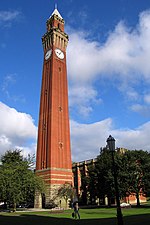Barber Institute of Fine Arts

The Barber Institute of Fine Arts is an art gallery and concert hall in Birmingham, England. It is situated in purpose-built premises on the campus of the University of Birmingham. The Grade I listed Art Deco building was designed by Robert Atkinson in the 1930s and opened in 1939 by Queen Mary. The first building to be purpose-built for the study of art history in the United Kingdom, it was described by architectural historian Sir John Summerson as representing "better than almost any other building (except, perhaps the RIBA in Portland Place) the spirit of English architecture in the 1930s." The layout of the museum is centred on a central concert hall which is surrounded by lecture halls, offices and libraries on the ground floor and art galleries on the first floor. In the 2005 Penguin Books publication Britain's Best Museums and Galleries, the Barber Institute was one of only five galleries outside London to receive five stars for having "Outstanding collections of international significance" (the others were the National Gallery of Scotland, Oxford University's Ashmolean Museum, Cambridge University's Fitzwilliam Museum and the Walker Art Gallery, Liverpool).
Excerpt from the Wikipedia article Barber Institute of Fine Arts (License: CC BY-SA 3.0, Authors, Images).Barber Institute of Fine Arts
Ring Road North, Birmingham Bournbrook
Geographical coordinates (GPS) Address Website External links Nearby Places Show on map
Geographical coordinates (GPS)
| Latitude | Longitude |
|---|---|
| N 52.450419444444 ° | E -1.9277277777778 ° |
Address
The Barber Institute of Fine Arts
Ring Road North
B15 2TS Birmingham, Bournbrook
England, United Kingdom
Open on Google Maps










